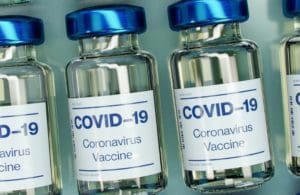How the U.S. government bolstered Moderna’s COVID-19 vaccine candidate

[Image courtesy of Wikipedia]
It was only a year ago that physicians in China identified unusual pneumonia cases that would later be associated with the novel coronavirus.
As impressive as the rapid pace of COVID-19 vaccine development has been, researchers have drawn on foundational work that stretches back almost two decades, said Barry Bloom, a research professor at Harvard University, in the recent webinar titled the “Race for the COVID-19 Vaccine: Latest Updates.”
And the Moderna vaccine candidate, in particular, has benefited from U.S. government support.
A marathon as well as a sprint
The race to develop COVID vaccines has roots stretching back to the terrorist attacks on September 11 and the anthrax attacks that followed in the subsequent weeks. The events led the National Academy of Sciences to convene a set of committees to examine the twin threats of terrorism and pandemics. The committees “concluded that we were enormously vulnerable and we had to do a lot of different things [to] protect the country,” said Bloom, who co-chaired a bioterrorism panel for the National Academy of Sciences at the time.
In 2002, severe acute respiratory syndrome (SARS) first appeared in China and took hold internationally within months. Effective public health interventions prevented SARS from becoming a pandemic.
In 2005, the U.S. Department of Health and Human Services (HHS) established the National Pandemic Influenza Plan to provide a blueprint for pandemic response. “At some point in our nation’s future, another virus will emerge with the potential to create a global disease outbreak,” Health and Human Services Secretary Mike Leavitt at the time.
The pandemic plan stressed the importance of antiviral drugs and vaccines. “It is a wonderful plan,” Bloom noted. But before COVID-19 hit, the report had “disappeared in a drawer somewhere in Washington,” he added.
But the U.S. government’s focus on vaccines to combat pandemics likely played a role in spurring further research into novel vaccine platforms.
DARPA and BARDA make vaccine investments
Government agencies such as the Defense Advanced Research Projects Agency (DARPA) and the Biomedical Advanced Research and Development Authority (BARDA) would play a role in vaccine development. DARPA “invests in very long term science and technology [projects] that will pay off in 20 years,” Bloom said.
The National Institute of Allergy and Infectious Diseases (NIAID) developed a stabilized SARS-CoV-2 spike immunogen (S-2P) that Moderna would later use in its messenger RNA platform.
DARPA was instrumental in the development of RNA vaccines and provided $25 million in financial support to Moderna in 2013 to pursue messenger RNA–based antibody drugs and vaccines. DARPA announced it was committing up to $56 million in additional funding to Moderna this October.
BARDA has committed another roughly $955 million to Moderna.
In all, the U.S. government vaccine contract with Moderna is worth roughly $1.5 billion. BARDA has also invested in producers of other COVID-19 vaccines.
BARDA was also instrumental in resetting researchers’ expectations for vaccine development, Bloom said. The organization set a goal of developing a vaccine 60 days after determining a pathogen’s DNA sequence. Moderna had a vaccine candidate 66 days after scientists identified its genetic sequence. “And that is a reflection of tremendous foresight by these technical agencies,” Bloom said. By identifying promising research and identifying companies to advance it, the government agencies have played a role in engineering COVID-19 vaccines. But the platform approach could also help fight future pandemics, given its ability to allow researchers to tweak antigens and genes to target a new pathogen.
The U.S. government’s support of the vaccine platform led to investigations into its use to treat infections from Middle East Respiratory Syndrome (MERS), influenza, Zika and HIV. “We had a background on these vaccines,” Bloom said. “The companies were pretty confident they would work [for the novel coronavirus], but it will take [trials] to find out how safe and effective for COVID they really are.”
Filed Under: clinical trials, Drug Discovery, Drug Discovery and Development, Infectious Disease




Nessun commento:
Posta un commento